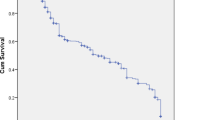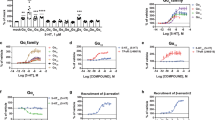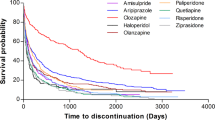Abstract
Although the Clinical Global Impression (CGI) and the Brief Psychiatric Rating Scale (BPRS) are both frequently used in drug trials for schizophrenia, their relative sensitivity in detecting differences between antipsychotics has not yet been examined. We therefore reanalyzed original patient data from all four pivotal, randomized controlled studies (n=1205) that compared amisulpride with haloperidol in patients with schizophrenia. The sensitivity of the BPRS vs the CGI-improvement and the CGI-severity scales in detecting between-drug differences was estimated by calculating effect sizes and their 95% confidence intervals for both continuous (standardized mean differences) and dichotomous outcomes (odds ratios). The primary end points were the last observation carried forward results at study end points pooling all studies, but the results of the observed cases at different study weeks and the results of the single studies were also examined. The effect sizes derived from the BPRS and from the CGI were similar. When the single studies were pooled, all outcomes analyzed showed a statistically significant superiority of amisulpride compared to haloperidol as early as 2 weeks after initiation of treatment. The CGI may be as sensitive as the BPRS in detecting efficacy differences between antipsychotic drugs, although specific studies with truly independent ratings would be needed for confirmation. The fact that it takes only 1–2 min to fill in the CGI justifies its use in addition to more specific scales in drug trials for schizophrenia. Further development and evaluation of the CGI is warranted.
Similar content being viewed by others
Log in or create a free account to read this content
Gain free access to this article, as well as selected content from this journal and more on nature.com
or
References
Adams CE, Coutinho E, Davis JM, Duggan L, Leucht S, Srisurapanont M et al (2005). Cochrane Schizophrenia Group. In: ‘The Cochrane Library’. John Wiley & Sons Ltd: Chichester, UK.
American Psychiatric Association (1987). Diagnostic and Statistical Manual for Mental Disorders, third revision, revised (DSM-III-R). American Psychiatric Association: Washington, DC.
American Psychiatric Association (1994). Diagnostic and Statistical Manual for Mental Disorders 4th edn. American Psychiatric Association: Washington, DC.
Beneke M, Rasmus W (1992). Clinical Global Impressions (ECDEU): some critical comments. Pharmacopsychiatry 25: 171–176.
Carrière P, Bonhomme D, Lempérière T (2000). Amisulpride has superior benefit : risk profile to haloperidol in schizophrenia: results of a multicentre, double-blind study (the Amisulpride study group). Eur Psychiatry 15: 321–329.
Cohen J (1988). Statistical Power Analysis for the Behavioral Sciences. Lawrence Earlbaum Associates: New York.
Colonna L, Saleem P, Dondey-Nouvel L, Rein W, Amisulpride Study Group (2000). Long-term safety and efficacy of amisulpride in subchronic or chronic schizophrenia. Int Clin Psychopharmacol 15: 13–22.
Costa e Silva JA (1989). Comparative double-blind study of amisulpride versus haloperidol in the treatment of acute psychotic states. In: Amisulpride. Expansion Scientifique Francaise: Paris. pp 93–104.
Davis JM, Chen N, Glick ID (2003). A meta-analysis of the efficacy of second-generation antipsychotics. Arch Gen Psychiatry 60: 553–564.
Delcker A, Schoon ML, Oczkowski B, Gaertner HJ (1990). Amisulpride versus haloperidol in treatment of schizophrenic-patients—results of a double-blind-study. Pharmacopsychiatry 23: 125–130.
Dossenbach M, Erol A, el Mahfoud Kessaci M, Shaheen MO, Sunbol MM, Boland J et al, IC-SOHO Study Group (2004). Effectiveness of antipsychotic treatments for schizophrenia: interim 6-month analysis from a prospective observational study (IC-SOHO) comparing olanzapine, quetiapine, risperidone, and haloperidol. J Clin Psychiatry 65: 312–321.
Guy W (1976). Clinical Global Impressions. In: ECDEU Assessment Manual for Psychopharmacology, revised (DHEW Publ No ADM 76-338). National Institute of Mental Health: Rockville, MD. pp 218–222.
Hamilton M (1960). A rating scale of depression. J Neurol Neurosurg Psychiatry 23: 56–62.
Haro JM, Kamath SA, Ochoa S, Novick D, Rele K, Fargas A et al (2003). The Clinical Global Impression-Schizophrenia scale: a simple instrument to measure the diversity of symptoms present in schizophrenia. Acta Psychiatr Scand 107: 16–23.
Hedlund JL, Vieweg BW (1980). The Brief Psychiatric Rating Scale (BPRS): a comprehensive review. J Oper Psychiatry 11: 48–65.
Kay SR, Fiszbein A, Opler LA (1987). The positive and negative syndrome scale (PANSS) for schizophrenia. Schizophr Bull 13: 261–275.
Khan A, Brodhead AE, Kolts RL (2004). Relative sensitivity of the Montgomery–Asberg depression rating scale, the Hamilton depression rating scale and the Clinical Global Impressions rating scale in antidepressant clinical trials: a replication analysis. Int Clin Psychopharmacol 19: 157–160.
Khan A, Khan SR, Shankles EB, Polissar NL (2002). Relative sensitivity of the Montgomery–Asberg Depression Rating Scale, the Hamilton Depression rating scale and the Clinical Global Impressions rating scale in antidepressant clinical trials. Int Clin Psychopharmacol 17: 281–285.
Klein HE, Dieterle D, Rüther E, Eben E, Nedopil N, Hippius H (1985). A double-blind comparison of amisulpride vs haloperidol in acute schizophrenic patients. In: Pichot P, Berner P, Wolf R, Thau K (eds). Psychiatry: The State of the Art. Perseus Books: Cambridge, Mass. pp 687–691.
Leon AC, Shear MK, Klerman GL, Portera L, Rosenbaum JF, Goldenberg I (1993). A comparison of symptom determinants of patient and clinician global ratings in patients with panic disorder and depression. J Clin Psychopharmacol 13: 327–331.
Leucht S, Pitschel-Walz G, Engel RR, Kissling W (2002). Amisulpride, an unusual ‘atypical’ antipsychotic: a meta-analysis of randomized controlled trials. Am J Psychiatry 159: 180–190.
Möller HJ, Boyer P, Fleurot O, Rein W (1997). Improvement of acute exacerbations of schizophrenia with amisulpride: a comparison with haloperidol. Psychopharmacology 132: 396–401.
Montgomery SA, Asberg M (1979). New depression scale designed to be sensitive to change. Br J Psychiatry 134: 382–389.
Nierenberg AA, DeCecco LM (2002). Definitions of antidepressant treatment response, remission, nonresponse, partial response, and other relevant outcomes: a focus on treatment-resistant depression. J Clin Psychiatry 62(Suppl): 5–9.
Overall JE, Gorham DR (1962). The Brief Psychiatric Rating Scale. Psychol Rep 10: 790–812.
Peuskens J, Bech P, Moller HJ, Bale R, Fleurot O, Rein W (1999). Amisulpride vs risperidone in the treatment of acute exacerbations of schizophrenia. Amisulpride Study Group. Psychiatry Res 88: 107–117.
Pichot P, Boyer P (1988). Etude multicentrique controlée en double insu, amisulpride (Solian 200) versus halopéridol à forte dose dans les états psychotiques aigus. Ann Psychiatrie 3: 326–332.
Puech A, Fleurot O, Rein W (1998). Amisulpride, an atypical antipsychotic, in the treatment of acute episodes of schizophrenia: a dose-ranging study vs haloperidol. Acta Psychiatr Scand 98: 65–72.
Rosenthal R (1991). Meta-Analytic Procedures for Social Research. Sage Publications: New York.
Rush AJ, Trivedi MH, Carmody TJ, Ibrahim HM, Markowitz JC, Keitner GI et al (2005). Self-reported depressive symptom measures: sensitivity to detecting change in a randomized, controlled trial of chronically depressed, nonpsychotic outpatients. Neuropsychopharmacology 30: 405–416.
Sèchter D, Peuskens J, Fleurot O, Rein W, Lecrubier Y, Amisulpride Study Group (2002). Amisulpride vs risperidone in chronic schizophrenia: results of a 6-month double-blind study. Neuropsychopharmacology 27: 1071–1081.
Speller JC, Barnes TRE, Curson DA, Pantelis C, Alberts JL (1997). One-year, low-dose neuroleptic study of in-patients with chronic schizophrenia characterised by persistent negative symptoms—Amisulpride v. haloperidol. Br J Psychiatry 171: 564–568.
Wahlbeck K, Tuunainen A, Ahokas A, Leucht S (2001). Dropout rates in randomised antipsychotic drug trials. Psychopharmacology 155: 230–233.
Wetzel H, Grunder G, Hillert A, Philipp M, Gattaz WF, Sauer H et al (1998). Amisulpride versus flupentixol in schizophrenia with predominantly positive symptomatology—a double-blind controlled study comparing a selective D-2-like antagonist to a mixed D-1-/D-2-like antagonist. Psychopharmacology 137: 223–232.
Ziegler B (1989). Study of the efficacy of the substituted benzamide amisulpride, versus haloperidol, in productive schizophrenia. In: Amisulpride. Expansion Scientifique Francaise: Paris. pp 73–82.
Acknowledgements
We are indebted to SanofiAventis for the possibility of analyzing individual patient data from their database. The study was supported by the APA/AstraZeneca Young Minds in Psychiatry Award 2004.
Author information
Authors and Affiliations
Corresponding author
Additional information
Supplementary Information accompanies the paper on the Neuropsychopharmacology website (http://www.nature.com/npp).
Supplementary information
Rights and permissions
About this article
Cite this article
Leucht, S., Engel, R. The Relative Sensitivity of the Clinical Global Impressions Scale and the Brief Psychiatric Rating Scale in Antipsychotic Drug Trials. Neuropsychopharmacol 31, 406–412 (2006). https://doi.org/10.1038/sj.npp.1300873
Received:
Revised:
Accepted:
Published:
Issue date:
DOI: https://doi.org/10.1038/sj.npp.1300873
Keywords
This article is cited by
-
Development of an adapted Clinical Global Impression scale for use in Angelman syndrome
Journal of Neurodevelopmental Disorders (2021)
-
Assessing and treating complex mental health needs among homeless youth in a shelter-based clinic
BMC Health Services Research (2020)
-
A phase 1/2, open-label assessment of the safety, tolerability, and efficacy of transdermal cannabidiol (ZYN002) for the treatment of pediatric fragile X syndrome
Journal of Neurodevelopmental Disorders (2019)
-
The effects of clinical illness severity and physical activity on health-related quality of life in schizophrenia
Quality of Life Research (2019)
-
Randomised controlled trial of simvastatin treatment for autism in young children with neurofibromatosis type 1 (SANTA)
Molecular Autism (2018)



